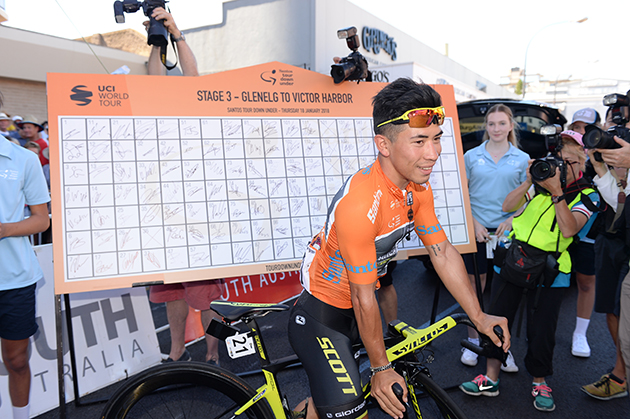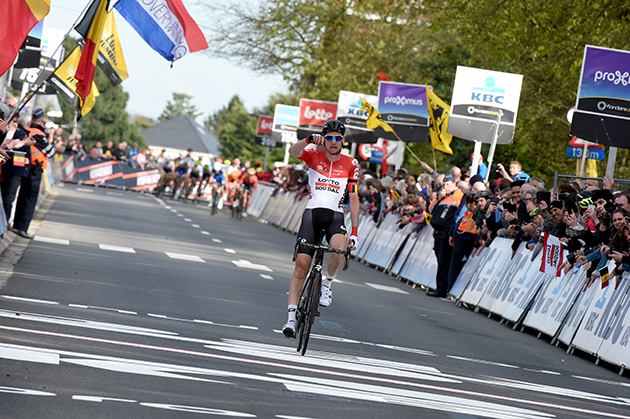Bicycle Racing News and Opinion,
Friday, January 11, 2019
Back to news and opinion index page for links to archived stories | Commentary | Our YouTube page
2018 Tour de France | 2018 Giro d'Italia
Let the rain kiss you. Let the rain beat upon your head with silver liquid drops. Let the rain sing you a lullaby. - Langston Hughes

Upcoming racing:
- January 14: Down Under Classic
- January 15 - 20: Santos Tour Down Under
- January 27: Cadel Evans Great Ocean Road Race
- January 27 - February 3: Vuelta a la Provincia de San Juan
Latest completed racing:
- January 1: GP Sven Nys
- December 30: Superprestige Dieghem
- December 28: Azencross
- December 26: Heusden-Zolder cyclocross
- December 23: Namur Cyclocross
- December 15: Scheldecross
- December 1: GP Hasselt
- November 18: Flandriencross
- November 11: Telenet Super Prestige Gavere Cyclocross
Lotto-Soudal team leaders ready for new season
Lotto-Soudal sent me this:
The upcoming Tour Down Under will be the first real event of the season for Lotto Soudal. The Belgian WorldTour team went through some changes as it was delighted to welcome some new riders and staff members. That way, Lotto Soudal is completely ready to make 2019 a successful season!
Lotto Soudal is excited to have the young and promising sprinter Caleb Ewan on board. The 24-year-old Australian will start the season in his home country during the Tour Down Under. After that, Ewan will take part in the inaugural edition of the UAE Tour. Soon after, Paris-Nice is scheduled where he will prepare for the first monument of the season, Milan-San Remo. Ewan hopes to have another shot at the victory on the Via Roma as he sprinted to a second place last year. After a short break, Ewan will possibly resume competition during the Tour of Turkey. In July, the Australian sprinter will debut in the Tour de France, where he will be looking for a stage win. His first Tour will possibly be preceded by the Giro in May and the Tour of Belgium in June.

Calen Ewan is headed back to the Tour Down Under. Sirotti photo
The spearhead of Lotto Soudal during the spring Classics will be Tiesj Benoot, who aims for another Classic win after his triumph in the Strade Bianche last year. Tiesj will race his first kilometres of the season in the Vuelta a San Juan (Argentina) and will then prepare for the Belgian opening weekend during an altitude training camp. Contrary to last year, the 24-year-old Belgian will start in both the Tour of Flanders and Paris-Roubaix. However, he will not compete in the Flèche Wallonne and Liège-Bastogne-Liège. For the third consecutive year, Tiesj will be at the start line of the Tour de France. By the end of the season, Benoot aims to be in top shape for the world championships which are organised in Yorkshire.
Thomas De Gendt - winner of the KOM jersey during the 2018 Vuelta a España - will include the three Grand Tours in his race schedule. He will once again be hunting stage wins with his typical offensive style of racing. Just like last year - when he won the Brabantse Pijl - Tim Wellens will target the Ardennes Classics, races he will prepare on Mallorca and in Bessèges, followed by Paris-Nice and the Volta a Catalunya. Wellens will take a short break before getting ready for the Tour de France. The 27-year-old Belgian will pursue top form by the time the world championships in Great-Britain start, where he will find a course suited to his abilities.

Time Wellens (shown winning the 2018 Brabantse Pijl) will target the Ardennes Classics in 2019. Sirotti photo
With a bronze medal in the time trial world championships last year, Victor Campenaerts proved to be close to the world’s best time trialists. The double European champion against the clock wants to take another step forward this year. Campenaerts will prepare for the start of the season with a long training camp in Namibia. The Belgian again aims for individual time trial success. In addition, he will ride the same two Grand Tours he started last year, the Giro d’Italia and the Vuelta a España.
How the bike business got to where it is today
Bicycle Retailer and Industry News is publishing a two-part series by Rick Vosper explaining the extraordinary changes the bicycle industry has undergone over the last few decades. Vosper knows his stuff and this is well worth the time spent reading it.
By Rick Vosper
This is Part 1 of a two-part series exploring the new market dynamic for the specialty retail segment, how we got there, and how the industry can respond and adapt to the new reality. This section is primarily focused on the “how we got where we are today” part of the story.
I note there is plenty of room here for alternative points of view and frankly, I expect a lively discussion.
Bike 1.0: When Schwinn Ruled the Earth
What I’m calling the 1.0 era is the postwar period of relative stability from 1950-75 (more or less). A single market leader, Schwinn, effectively controlled much of both the supply and retail sides of the specialty business channel. Schwinn had a well-organized, well-managed and marketed, vertically integrated supply chain based on domestic production. At the same time, it created, nurtured and maintained a strong network of semi-independent retailers.
The resulting dynamic was a largely stable market and birth of what we would now recognize as the modern independent bicycle retail landscape. But Schwinn’s efforts were so successful the company was subject to a restraint of trade lawsuit in 1957, dragging on for 10 exhausting years. As a result, Schwinn abandoned its system of independent wholesalers/distributors, moved to an in-house distribution model and lost much of its control of retailers. (More about the lawsuit and other topics are available in the very thorough Wikipedia article on the history of Schwinn.)
Nevertheless, stability continued though the Bike Boom of the early to mid-'70s and the death of Bike 1.0 as Schwinn’s control inexorably declined as the result of a changing situation it failed to adapt to.
Bike 2.0: End of the Bike Boom, Rise of the Mountain Bike, and the Era of Perfect Competition
During the Bike Boom, lightweight drop-bar imports had already claimed significant market share and with them, increasing power for their independent importers/distributors. The trend continued and accelerated even as the boom turned to bust, with the initial introduction of quality Asian bikes, originally from Japan and later, as value of the yen climbed, from Taiwan and eventually mainland China.
In parallel, a new era of U.S. manufacturing of high-quality bikes from companies like Trek and later Cannondale began to affect the market. The table was already set for the mass introduction of mountain bikes in the early 1980s and all that came with them.
The mountain bike’s success was not merely based on an exciting new product category, but on a new generation of leaner, more agile brands and an entirely new business model, one largely powered by Asian-based manufacturing and finance. Trek, Specialized, Giant, Cannondale, Shimano and every other major industry player today came of age during Bike 2.0.
It was also the Golden Era of the American independent bicycle retailer, eventually peaking at more than 6,100 shop locations (“doors”) in 2001 at the dawn of the 3.0 era.
You can read the entire first installment here.
Back to news and opinion index page for links to archived stories | Commentary









